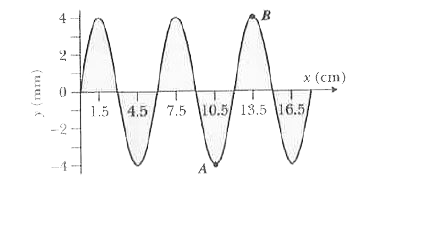(i) For the wave on a string described in previous problem do all the points on the string oscillate with the same (a)frequency, (b) phase, ( c ) amplitude ? Explain your answers. (ii) What is the amplitude of a point 0.375m away from one end ?
(i) All the points on the string
(a) have the same frequency except at the nodes ( where frequency is cosθ)
(b) have the same phase every where in one loop except at the nodes.
(c ) however, the amplitude of vibration at different points is different.
(ii) From y ( x,t) 0.06sin(2π3x)cos(120πt)
The amplitude at x=0.375m is 0.06sin.2π3×1=0.06×sin.2π3×0.375
=0.06sin.π4=0.06√2=0.042M
Topper's Solved these Questions
- WAVESBOOK - VIKRAM PUBLICATION ( ANDHRA PUBLICATION)CHAPTER - WAVESEXERCISE - ADDITIONAL EXERCISES
6 Videos
- WAVESBOOK - VIKRAM PUBLICATION ( ANDHRA PUBLICATION)CHAPTER - WAVESEXERCISE - LONG ANSWER QUESTIONS
6 Videos
- WAVE OPTICS BOOK - VIKRAM PUBLICATION ( ANDHRA PUBLICATION)CHAPTER - WAVE OPTICS EXERCISE - Problems
6 Videos
Similar Questions
(i) For the wave on a string described in question, do all theh points on the string oscillate with the same (a) frequency, (b) phase, (c) amplitude ? Explain your answers. (ii) What is the amplitude of a point 0.375m away from one end?
View Solution(i) The transverse displacement of a string (clamped at its two ends ) is given by y(x,t)=0.06sin[2π3x]cos120πt,
where x, y are in m and t is in s.
Do all the points on the string oscillate with the same (a) frequency, (b) phase, (c) amplitude ? Explain your answers.
View Solution
Knowledge Check
The displacement of a vibrating string versus position along the string is shown in the figure. The periodic wave have a speed of 10.0cm/s. A and B are two points on the string.

What is the amplitude of the wave?A2 mmB4 mmC12 mmD8 mm
The transverse displacement of a string (clamped at its two ends ) is given by y(x,t)=0.06sin(2π)3xcos120πt,
where x, y are in m and t is in s.
Do all the points on the string oscillate with theh same
(a) frequency (b) phase (c) amplitude
Explain your answer.
View SolutionAdjacent antinodes of a standing wave on a string are 15.0 cm apart. A particle at an antinode oscillates in simple harmonic motion with amplitude 0.850 cm and period 0.0750 s. The string lies along the +x-axis and is fixed at x=0.
(a) find the displacement of a point on the string as a function of position and time.
(b) Find the speed of propagation of a transverse wave in the string.
(c) Find the amplitude at a point 3.0 cm to the right of an antinode.
View SolutionAdjacent antinodes of a standing wave on a string are 15.0 cm apart. A particle at an antinode oscillates in simple harmonic motion with amplitude 0.850 cm and period 0.0750 s. The string lies along the +x-axis and is fixed at x=0.
(a) find the displacement of a point on the string as a function of position and time.
(b) Find the speed of propagation of a transverse wave in the string.
(c) Find the amplitude at a point 3.0 cm to the right of an antinode.
View SolutionA transverse harmonic wave is propagating along a taut string. Tension in the string is 50 N and its linear mass density is 0.02kgm–1 The string is driven by a 80Hz oscillator tied to one end oscillating with an amplitude of 1mm. The other end of the string is terminated so that all the wave energy is absorbed and there is no reflection
(a) Calculate the power of the oscillator.
(b) The tension in the string is quadrupled. What is new amplitude of the wave if the power of the oscillator remains same?
(c) Calculate the average energy of the wave on a 1.0m long segment of the string.
View SolutionTwo waves, each having a frequency of 100 Hz and a wavelength of 2.0 cm, are travelling in the same direction on a string. What is the phase difference between the waves (a) if the second wave was produced 0.015 s later than the first one at the same place, (b) if the two waves were produced at the same instant but the first one was produced a distance 4.0 cm behind the second one ? (c) If each of the waves has an amplitude of 2.0 mm, what would be the amplitudes of the resultant waves in part (a) and (b) ?
View SolutionTwo waves, each having a frequency of 100 Hz and a wavelength of 2.0 cm, are travelling in the same direction on a string. What is the phase difference between the waves (a) if the second wave was produced 0.015 s later than the first one at the same place, (b) if the two waves were produced at the same instant but the first one was produced a distance 4.0 cm behind the second one ? (c) If each of the waves has an amplitude of 2.0 mm, what would be the amplitudes of the resultant waves in part (a) and (b) ?
View SolutionA 660 Hz tuning fork sets up vibration in a string clamped at both ends. The wave speed for a transverse wave on this string is 220ms−1 and the string vibrates in three loops. (a) Find the length of the string. (b) If the maximum amplitude of a particle is 0.5 cm, write a suitable equation describing the motion.
View Solution
